|
|
The New York Times reports today on what it calls the "Pompeii of World War II," an abandoned village in Italy now "overtaken by vines and lime trees."
That village is San Pietro, an "11th-century cobblestone mountain village nestled among wild figs and cactus," as well as the scene of months of horrific fighting between Allied and German troops.
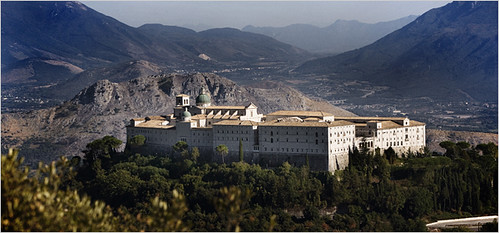 [Image: The reconstructed abbey atop Monte Cassino, as photographed by Stephanie Kuykendal for The New York Times]. [Image: The reconstructed abbey atop Monte Cassino, as photographed by Stephanie Kuykendal for The New York Times].
Nearby, atop Monte Cassino, was "one of the holiest sites in Christendom," a monastery "founded by St. Benedict in the sixth century, a shrine of Western civilization" – indeed, "a center of art and culture dating back nearly to the Roman Empire" – which the Allies bombed into rubble, suspecting (or not suspecting, but caught up nonetheless in the machinations of bad intelligence and unquestioned orders) that German troops had taken refuge there.
"After the battle ended," we read, the entire chain of small mountain valleys in which San Pietro once stood "would be left uninhabitable for years, demolished by Allied bombs, beset by malaria."
So this may be a bit rambling, and otherwise unrelated, but while working on The BLDGBLOG Book tonight (due out Spring 2009! from Chronicle Books! buy loads!), I was re-reading W.G. Sebald's extraordinary On the Natural History of Destruction.
At one point in the book Sebald describes the literally shell-locked life of people who had managed to stay on in the destroyed cities of northern Germany during WWII. He describes "the unappetizing meals they concocted from dirty, wrinkled vegetables and dubious scraps of meat, the cold and hunger that reigned in those underground caverns, the evil fumes, the water that always stood on the cellar floors, the coughing children and their battered and sodden shoes."
Battling grotesquely bloated rats and enormous green flies, these "cave dwellers," as Sebald calls them, lived with the "multiplication of species that are usually suppressed in every possible way," amidst the gravel and shattered windowframes of their now "ravaged city."
Based on an eyewitness account written by an Allied Air Commander, Sebald then refers to "the terrible and deeply disturbing sight of the apparently aimless wanderings of millions of homeless people amidst the monstrous destruction, [which] makes it clear how close to extinction many of them really were in the ruined cities at the end of the war."
For some reason the next line just haunts me: No one knew where the homeless stayed, although lights among the ruins after dark showed where they had moved in. Which leads me to ask myself whether it's simply a factor of my age – I'm not exactly getting younger here – though I do drink a lot of orange juice – or if it's something more closely related to the weirdly militarized political climate in which we now live, but I've started to react to things like this with a kind of concentrated studiousness, as if reading – absurdly – for advice on how to survive my own generation's coming, perhaps even more calamitous, future.
What "monstrous destruction" of world war and oil shortages and global terror and climate change might we, too, have to face someday?
In twenty years' time will I be out holding up some pathetic light among the ruins of a destroyed city, wondering where my wife is, dying of thirst, deaf in one ear, covered in radiation burns?
Or is that just a peculiarly American form of pessimist survivalism? Or do I just read too much Sebald?
Wired just published a conversation between neurologist Oliver Sacks and journalist Steve Silberman – the latter of whom is also now my neighbor – hello, Steve! – about music, memory, the neurological benefits and pressures of sound, blindness, and the (possible) dangers of urban noise pollution.  [Image: Luigi Russolo and his noise machines... something otherwise irrelevant to this post]. [Image: Luigi Russolo and his noise machines... something otherwise irrelevant to this post].An excerpt: Wired: When you were growing up, hearing music often required going to see it performed. But iPods make music ubiquitous, like mental air-conditioning. What have we gained or lost by that?
Sacks: At first it would seem to be a wonderful gain. Darwin might have had to go to London to see a concert. But I can't help wondering if the incidence of earworms and musical hallucinations is higher now, with background music in every public place. You can't go to a restaurant without music, and they get offended if you ask them to turn it off. They feel it's part of their creativity – they're doing it for you.
The brain is very sensitive to music; you don't have to attend to it to record it internally and be affected by it. I think we may be exposed to too much loud and repetitive music. One patient of mine has epileptic seizures induced by music and has to wear earplugs in New York City. It's a dangerous place for him. Read the rest at Wired. For some reason, though, this reminds me of an anecdote I read five or six years ago about French minimalist/proto-ambient composer Erik Satie – about whom you can read more in David Toop's excellent book Ocean of Sound. So Satie, the anecdote goes, once tried to compose – and have performed, live, in a Paris restaurant – literal background music. It was music meant to flavor a room the way perfume might scent the boudoir: something you don't quite notice but is there nonetheless. Or, in a slightly more famous analogy, it was music meant to be experienced like furniture: it may be there in the room with you – but you didn't have to pay attention to it. It was just part of the design. In any case, social conventions of the time being what they were, whenever Satie's musicians, installed there in the restaurant, started to play, all the diners would stop talking, put their utensils down, and politely listen. But that wasn't the point. Satie thus had to walk around the restaurant almost continuously for the next half-hour, passing from patron to patron, demanding that they stop listening to his music...
The Observer this week takes a look at the sounds of cities. "For some," we read, "living in a city is a loud, unpleasant babble of intrusive noise. For others it is a soundscape of calming tones that lift the spirits and brighten the day. Now a £1m, three-year research project is building a database of noises that people say improve their environment. It will translate those findings into design principles to help architects create sweeter-sounding cities." Wonderfully, the leader of the study "is looking for members of the public to take part in mass 'sound walks' through cities or in laboratory listening tests, where the team will use MRI scanners to measure participants' brain activity as they are played a variety of urban noises." They will thus develop an artificial soundtrack for the urban future.  Some of the "surprisingly agreeable" sounds discovered thus far include "car tyres on wet, bumpy asphalt, the distant roar of a motorway flyover, the rumble of an overground train and the thud of heavy bass heard on the street outside a nightclub." We even read that the sounds of "skateboarders practising in underground car parks" are considered "kind to the ear." As part of his auditory interest in urban design, then, the leader of the study wants "to see more water features and sound-generating sculptures next to busy roads," and he wants to use buildings and trees "to scatter, deaden or reflect sound." The entirety of city space could thus be instrumentalized – literally made more musical. However, I'm curious how this study will deal with different moral and/or cultural expectations for urban noise. The sounds of neighbors having sex, for instance, and those who voyeuristically listen-in: should you play copulatory noises through hidden speakers in the downtown park? Thus calming a certain segment of the population? What about the Muslim call to prayer? And could your city someday start a season-long program, inviting sonic grandmasters to come in once a month and play new sounds for the whole metropolis, resoundtracking highways and civic infrastructure, giving the sewers a tune, adding audio to everything? Or is that just called a radio DJ? (Thanks, Nicolai! Earlier on BLDGBLOG: Audio Architecture and New York City in Sound).
 [Image: The South Tower of the World Trade Center on 9/11; photographer unknown]. [Image: The South Tower of the World Trade Center on 9/11; photographer unknown].On the flight over to Chicago last week I read an intense and frightening article in Discover about the wide range of post-9/11 illnesses that have begun to develop in New York City. As most people no doubt know, tens upons tens – if not hundreds – of thousands of people literally inhaled the World Trade Center towers in the collapse and aftermath of 9/11. It was the malign aerosolization of late modernist architecture, producing "the most dangerous atmospheric conditions ever to occur on American soil." The "sky was glittering with glass" that day: A toxic cloud composed of industrial waste and human remains crept out from the aching, smoldering pit at Ground Zero and wound its way into the adjoining streets. Its vapors circled around and up buildings, pumped in and out of nostrils, mouths, and lungs, and stung the eyes of every woman, child, man, bird, and beast within a wide range. It spread itself on building walls and inside boiler rooms and left its trail on parked cars, handrails, and public benches. That day, New York City was blinded by a perpetually sickening haze. It poisoned the minds of politicians who acted with hubris and paranoia. It obscured the vision of responders and residents, many of whom acted with heroism and reckless bravado, never thinking that their actions might be endangering themselves, their families, their cities, and their very future. The cloud billowed southward, over the river, enveloping everything in the dust and debris of blown-apart lives. Breathing this "toxic cloud" has led to people coughing up "brown and pinkish-bloody" clots of tissue; it has led to organ failure; and the article even introduces us to a man who, five years later, "started bleeding everywhere – out of my ears, mouth, penis, and anus, and none of the doctors could figure out why." Indeed, the "number of seriously ill New Yorkers could climb to 300,000 in the near future," and these serious illnesses run the gamut from "internal chemical burns" and "chronic respiratory and gastrointestinal conditions," many of which will be fatal, to "rare blood cancers" and asthma attacks.  [Image: "Within a few hours’ time, a person exposed to the fumes could ingest toxins that would otherwise take a year to accumulate in a typical environment"; photographer unknown]. [Image: "Within a few hours’ time, a person exposed to the fumes could ingest toxins that would otherwise take a year to accumulate in a typical environment"; photographer unknown].None of which seems surprising when you read about what actually went up in the air that day: The Twin Towers contained tens of thousands of computer terminals, each housing about four pounds of lead, and an untold number of fluorescent bulbs that contained mercury. Released metal particles from the smoldering pit of the World Trade Center were so fine that they could easily slip past a paper face mask and reach deep into lung tissue, where they are poorly soluble in lung fluid. Metals and glass can remain trapped there for long periods of time and make their way into the heart. It's also important to note, for my voting American readers, that the leadership of Rudy Giuliani does not fare very well in this article.  [Image: After the towers' collapse; photographer unknown]. [Image: After the towers' collapse; photographer unknown].After much more detail about both the "plume" itself and about the various environmental failures that occurred up and down the political chain of command, the article ends magnificently: "While the courts try to determine who is responsible for the environmental debacle following 9/11, countless New Yorkers continue to live and work near Lower Manhattan with the assumption that it is safe. The dust is now out of sight, out of mind, and possibly in their lungs, hearts, and bloodstreams." So this is what happens when you pulverize and burn modern architecture: plumes of cadmium, thallium, benzene, silver, zinc, osmium, carbon monoxide, sulfuric acid, nickel, and lead drift outward into the city, snowing invisibly into local waterways, settling on windowsills and dusting the floors of homes, shops, and offices, salting food on plates at outdoor cafes, entering bloodstreams and sticking to clothes. Fiberglass and fire retardants, arsenic and rubber – asbestos, soot, and paper – all enter the atmosphere and form undetectable weather systems too vaporous and ghostlike to track. Which leads me to wonder about what sort of post-bombardment aerial conditions existed in cities like Dresden or Hiroshima, after they were destroyed in World War II, when architecture was not made from such things – when there were not home computers and circuitboards to burn and when homes weren't full of flame retardant fabrics and PVC. Were different and earlier forms of pulverized architecture somehow safer to breathe? In fact, if I can be excused a brief moment of contextually inappropriate speculation, would it be possible to impregnate buildings with good things – with good chemicals: with vitamins and medicines and even seeds – so that future 9/11s release beneficial plumes and so that the inhalation of architectural smoke is no longer catastrophic? Or would that just encourage terrorist attacks, arson, and urban warfare? In any case, the article in Discover is well worth a half-hour or so of your time – especially if you lived or worked in lower Manhattan or Brooklyn during the weeks after 9/11.
 [Image: Famous buildings in Chicago, via the Chicago Architecture Foundation]. [Image: Famous buildings in Chicago, via the Chicago Architecture Foundation].I'm in Chicago, wandering around the city for the first real time since I left six years ago, looking at a hundred thousand new brick-and-limestone private condo developments, crossing and recrossing the Chicago River on foot, staying in various hotels, visiting houses, checking out gigantic roof decks, writing up stories for work, attending dinners, feeling almost overwhelmingly nostalgic, giving a talk about BLDGBLOG, hanging out soon with this guy... but I'll almost definitely be back in San Francisco before I have time to post again. In the meantime, hello from Chicago!
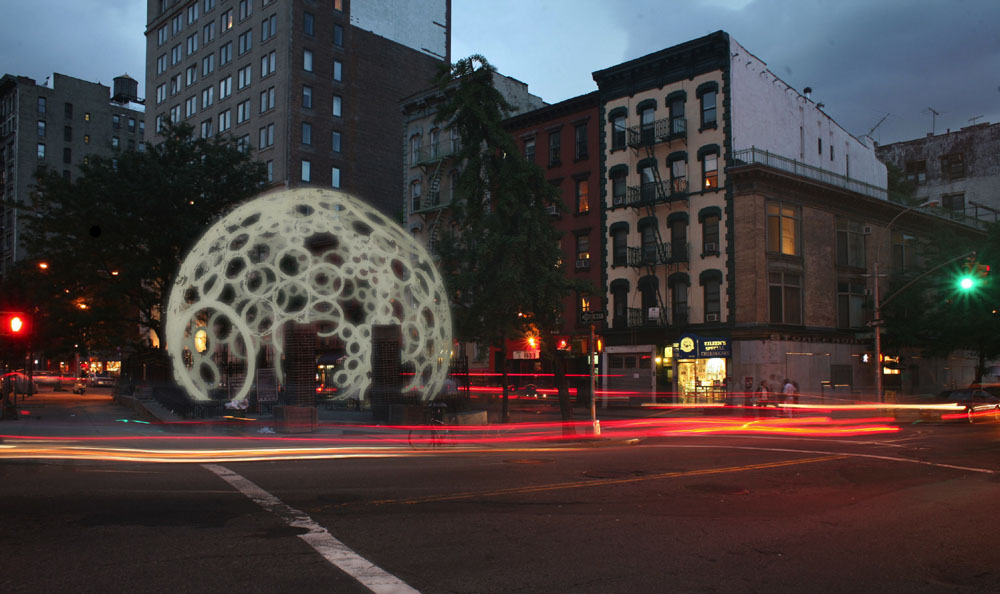 [Image: Glowing pavilion by Minsuk Cho, at the Storefront for Art and Architecture, NYC]. [Image: Glowing pavilion by Minsuk Cho, at the Storefront for Art and Architecture, NYC].New York's Storefront for Art and Architecture today kicks off nearly a month's worth of events, in celebration of the Storefront's 25th anniversary. The list of speakers is long and well-curated; they'll be speaking inside Minsuk Cho's pavilion, in Petrosino Park, and the nightly events will last until October 16. So if you're in New York, you now have something to do every night for the next 26 days. Be sure to stop by. (The Storefront for Art and Architecture, of course, also hosted Postopolis!)
This is how the world will end: with a quiet bit of news on the BBC. I got home from work last night to find out, incredibly, that "[h]undreds of people in Peru have needed treatment after an object from space – said to be a meteorite – plummeted to Earth in a remote area."  [Image: A spectacular glimpse of the Leonid meteor shower, circa 1999; photo by Wally Pacholka]. [Image: A spectacular glimpse of the Leonid meteor shower, circa 1999; photo by Wally Pacholka].The object "left a deep crater" that immediately began "spewing fetid gases," and everyone who has "visited the scene" has since "been complaining of headaches, vomiting and nausea." A local villager, worried for himself and for his neighbors, says: "We don't know what is going on at the moment, that is what we are worried about." It's a virus from space! So I half-seriously expected to wake up this morning and read that the entire population of Peru has been wiped out by clouds of alien zombie-dust; that militaries have been mobilized; that families are now scrambling in all possible directions to find a safety that will no longer come; and that the catastrophe continues to spread... In eight days' time it reaches the streets of San Francisco, where I'll be live-blogging the outbreak from behind a plywood barricade. But it turns out that we don't need to worry after all: the scientists quoted in the original article are right. It wasn't an object from space at all but "a fireball," the appearance of which led people to hike out into the wild and find "a lake of sedimentary deposit, which may be full of smelly, methane rich organic matter." This "rich organic matter" made everyone ill – infected by rot and vegetation. It's a kind of petro-illness.
 [Image: Habitat 825, by Lorcan O'Herlihy]. [Image: Habitat 825, by Lorcan O'Herlihy].In an earlier post I mentioned a housing project by LA architect Lorcan O'Herlihy. That building, called Habitat 825 – built right next door to the Schindler House and deliberately designed so as to cast no shadows onto its historically listed neighbor – has a particularly memorable use of the color lime green. Now, thanks to a coworker of mine, I have a few photos...   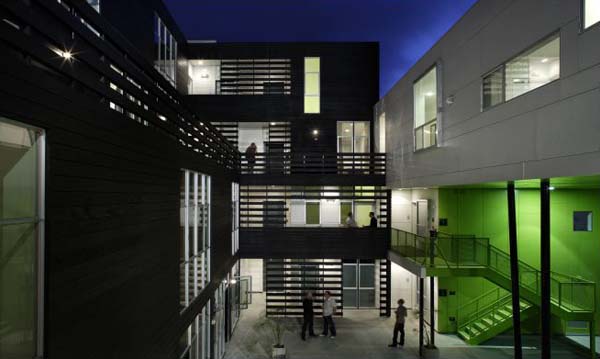 [Images: Habitat 825, by Lorcan O'Herlihy]. [Images: Habitat 825, by Lorcan O'Herlihy].And I love this building! O'Herlihy's use of volume and color just knocks me out. For more Lorcan O'Herlihy, visit the firm's website or read this earlier post on BLDGBLOG. (Thanks, Chelsea!)
In the Guardian today, Jonathan Glancey reports on London's subterranean housing boom, pointing out that the urge for literally underground architecture has now hit the city's public sector.  Case in point: the St. Marylebone school. With the advisory input of their architect, the school's officials decided that "the only way the school could expand physically was onwards and downwards through its pocket-sized playground." Unfortunately, the resulting project, a "fine example of intelligent urban design, thoughtful landscape gardening, worthwhile architecture and quiet delight," dug straight into the "remains of some 5,000 corpses" almost as soon as construction began. Rather than unearthing some super-virulent strain of the Black Death, however, sending all the small schoolgirls home coughing, decimating the population of northwest Europe... the project was completed to everyone's satisfaction, and now St. Marylebone has an underground gymnasium. And Glancey likes what he sees. He concludes: It is also a project that deserves to set a precedent for much new city architecture. Much of this can be built underground, when not in flood zones, in one form or another, sometimes because this is the only way to go for a client unable to afford the price of land, or else restricted by perfectly sound conservation policies, and sometimes because – like most supermarkets, shopping malls and other structural detritus – it should be, as a matter of common decency, buried out of sight. I'm not exactly in agreement with him that we should start putting our supermarkets underground; in fact, an upcoming article in Dwell makes the opposite case quite convincingly: i.e. supermarkets shouldn't be windowless boxes but pleasantly open places in which to walk around, complete with outdoor horizons and panoramic views. But imagine the future settings for novels and films! Underground malls in Canterbury. Irish theme-bars 27 stories below the surface of the Earth. Three kilometers of escalators take you down and down – and down – passing through mirrored corridors... till you arrive at the local arts cinema. There are rumors of a BMW dealership another mile or so below. (Thanks, Nicky! Earlier on BLDGBLOG: Hello. Welcome to my squash cave)
After participating in a roundtable discussion with architect Lorcan O'Herlihy yesterday at Dwell on Design, I decided to look into his work a bit more – and it's been a great way to spend time. Lorcan has both a great sense of modernist architectural volume and a brilliant eye for color; the lime green he used on a multi-unit residence in West Hollywood, for instance, is extraordinary. I'll see if I can dig up some photos of the finished building. The following images, meanwhile, are just a random look at three or four of O'Herlihy's most interesting projects. To start with, here is a recent building in Los Angeles, called Gardner 1050.   [Images: Gardner 1050, by Lorcan O'Herlihy]. [Images: Gardner 1050, by Lorcan O'Herlihy].I'm a particular fan of the outdoor footbridges, as they criss-cross a shared entry courtyard in the all-pervading sunlight of LA. O'Herlihy, you see, has a small thing for residential bridges: these next images feature the Fineman residence – a house with its own "enclosed glass-walled bridge." 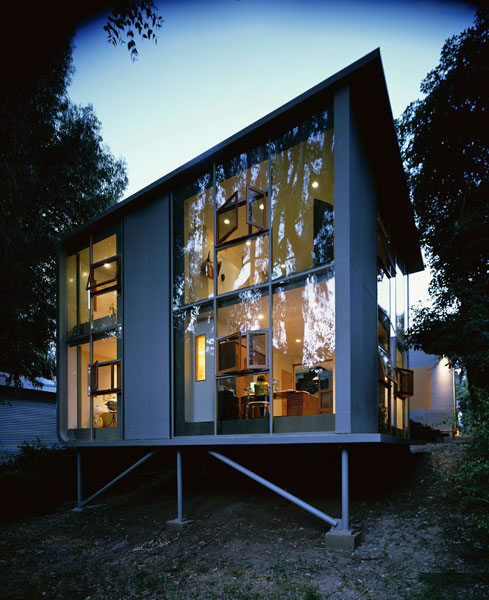  [Images: The Fineman house, by Lorcan O'Herlihy]. [Images: The Fineman house, by Lorcan O'Herlihy].This next image gives us a bird's-eye rendering of O'Herlihy's proposal for a new dormitory and "Educational Facility" at CalArts – more information about which is available on O'Herlihy's website.  [Image: Proposal for CalArts, by Lorcan O'Herlihy]. [Image: Proposal for CalArts, by Lorcan O'Herlihy].In a nutshell, though, the circulation-friendly building complex uses a "shifted" east-west axis "to take full advantage of the complete spectrum of the optimal solar angle." This not only "supports the passive ventilation system," it means that "the need to artificially and mechanically condition an internal corridor year round can be eliminated resulting in a significant reduction in the net energy demand over the life of the building." Below, then, you see the architectural logic behind O'Herlihy's Norton Avenue Lofts, going from a bare-bones diagram of abstract spatial volumes –  [Image: The Norton Avenue Lofts, by Lorcan O'Herlihy]. [Image: The Norton Avenue Lofts, by Lorcan O'Herlihy].– to the final renderings of the project's exterior.   [Images: The Norton Avenue Lofts, by Lorcan O'Herlihy]. [Images: The Norton Avenue Lofts, by Lorcan O'Herlihy].In any case, I know I'm not exactly going into much detail with these projects – in fact, I'm just sort of whipping out a bunch of cool, unrelated images without offering any real or substantive analysis – but I still want to point out one more: O'Herlihy's 12 Houses, an almost Bach-like study in formal variation. 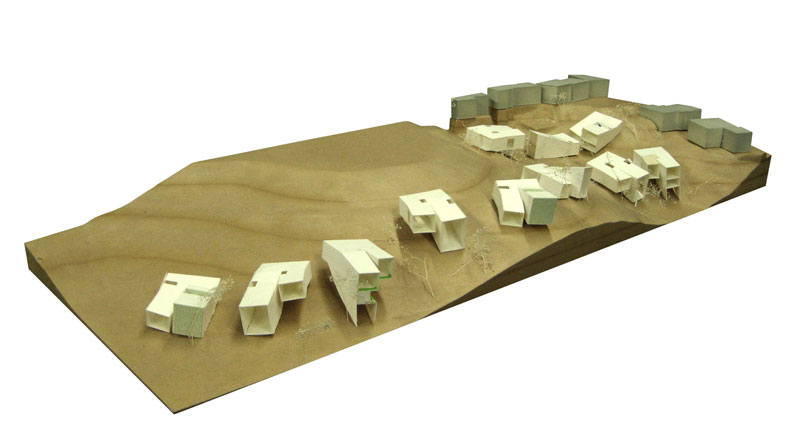 [Image: 12 Houses by architect Lorcan O'Herlihy]. [Image: 12 Houses by architect Lorcan O'Herlihy].The original idea behind 12 Houses, we read, was "to create individualized identities and experiences for each house using shared elements of design and construction." As a result, O'Herlihy generated "four prototypes": Starting from a simple main floor plan consisting of two adjoined rectangular bars, a second floor is created by pulling up or pushing down one bar – either in complement or contrast to the topography of each site. From these two formal gestures, four variations emerge: up, down, long, short. Further variation is produced by siting (for privacy and views), adjustment of each prototype in response to stringent building envelope limits, and a carefully-developed palette of exterior/interior materials. I absolutely love the puzzle piece-like results.  [Image: 12 Houses by architect Lorcan O'Herlihy]. [Image: 12 Houses by architect Lorcan O'Herlihy].But let me pre-empt some criticism right away: yes, this is simply another kind of suburban sprawl, destined to grace tasteless cul-de-sacs, surrounded by well-watered lawns and reachable only by private automobile – yet the houses are also beautifully devised and formally stimulating. I also have an active soft spot for systems like this, and so I'm easily seduced by basic variations upon simple architectural plans – the same animating principal behind Palladianism, for instance. The mathematics of the ideal villa, indeed.  [Image: 12 Houses by architect Lorcan O'Herlihy]. [Image: 12 Houses by architect Lorcan O'Herlihy].O'Herlihy's 12 Houses are apparently slated for construction, too: they should be ready for inhabitation by Spring 2008. For more projects by Lorcan O'Herlihy, book a visit to his firm's website.
Yesterday was another good day at Dwell on Design, with a handful of talks in the morning followed by more general mingling in the exhibition space all afternoon. 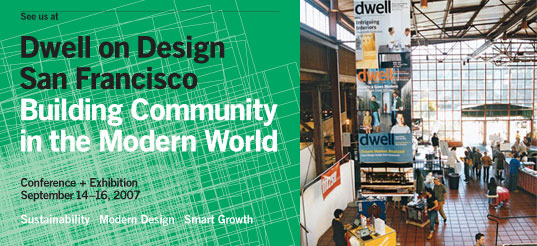 North Carolina-based architect Frank Harmon – behind the exquisite Prairie Ridge Eco Station, pictured below, designer of Duke University's Smart House, and architect of many, many other great projects – gave the final speech of the conference, presenting his firm's work in the context of "new regionalism."  [Images: The Prairie Ridge Eco Station, an open air classroom designed by Frank Harmon]. [Images: The Prairie Ridge Eco Station, an open air classroom designed by Frank Harmon].Frank talked about the use of local materials; how to survive humidity, thunderstorms, summer dry spells, and the harsh winter cold without using electricity, putting architecture itself to use as a local climate modification system; and, finally, the blending of traditional design styles with what could be called global architectural modernism. He showed us a church, a pottery museum, the aforementioned Prairie Ridge Eco Station, an ironworkers' studio, and a few other of his firm's own projects. One of the most interesting sequences of images he showed was a quick sketch describing the sinusoidal shape of local wind patterns over the North Carolina landscape – which he then clicked away from to reveal the wing-like angled slope of a roof he'd designed to fit into the local windscape almost perfectly. It's hard to exaggerate how exciting I find that sort of thing. In any case, Frank Harmon's work is well worth checking out in more detail – and a great Q&A with him is coming up in a future issue of Dwell (where, in full disclosure, I now work) – so here's his website. But I wanted to follow up here with a few other quick thoughts – because I was on a panel with Frank after his talk, alongside Gwynne Pugh, Lorcan O'Herlihy, and Reed Kroloff, and in the spotlit glare of being on stage I might have been a tad less articulate than I'd hoped to be. Briefly, then, I mentioned a climate map, published earlier this summer, in which Europe has been re-mapped according to what its regional climates will be like in the year 2071 A.D.  The map is initially quite confusing, but it shows that London will have the climate of Lisbon, Portugal; Berlin will have the climate of northern Algeria (!); and Oslo will feel like Barcelona (and so on). So the question I wanted to propose to the other speakers was: how can architects account for these sorts of wild fluctuations in both weather and climate through architectural design? How can a building be prepared – structurally, materially – for future climate change? Or, more relevant to Frank Harmon's presentation, especially in the context of "new regionalism": what if you build a house that's perfect for North Carolina as North Carolina now exists – but what happens to that house in, say, twenty years' time, when North Carolina is more like Houston, Texas, or even like Key West? In which case, what about the new, modern, glass-walled housing stock of Berlin when it finds itself baking in Algiers-like desert temperatures? (How I would love to see sand dunes rolling through the streets of Berlin!) This, if anything, is the real new regionalism: a regionalism that includes future transitions so out of the ordinary that they verge on science fiction. It's sci-fi regionalism – architectural design in an era of global climate change.
One of the presenters this morning at Dwell on Design – I believe it was Gwendolyn Wright – mentioned a fire department that had once employed a psychiatrist to help solve mysterious house fires. 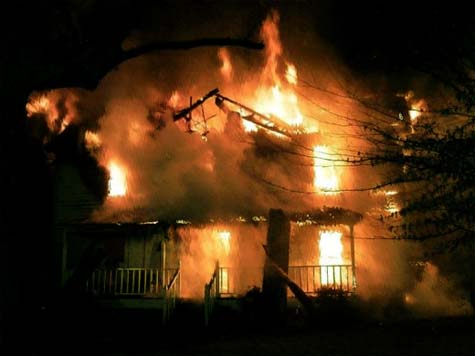 They had noticed, apparently, that some recent fires involving stately old Victorians occurred immediately after those houses' residents had got divorced. And it wasn't just insurance fraud.  What really happened, the psychiatrist proposed, was that the houses themselves had been blamed, or scapegoated, for the interpersonal strife that once occurred within them – and those houses had thus been destroyed. It was anti-maritally inspired arson – another front in the war against architecture – with the house as the enemy to be destroyed. At least that's what I think the speaker said. (Note: I'm sure there were many other factors involved in those fires – and this is, by no means, some over-arching explanation for all domestic fires in the United States – but it did make a fascinating anecdote: desperate people depressed, even enraged, by architecture, setting fire to the very thing they think has limited them).
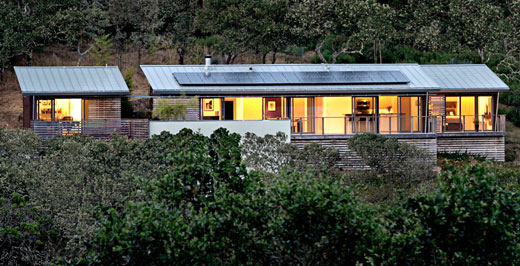 [Image: The Glidehouse by Michelle Kaufmann]. [Image: The Glidehouse by Michelle Kaufmann].Architects Michael McDonough and Michelle Kaufmann are now on stage here at Dwell on Design. Their topic is "Well-behaved Homes." Michael, in full performance mode, explains that building houses using conductive materials (metal, for instance, which is also used to make pots and pans) instead of using insulating materials (he specifically refers to aerated autoclave concrete, used in the majority of European houses) is inherently problematic from the standpoint of energy efficiency and climate control. He talks about the importance of mechanical engineers in coming to understand the movement of air through enclosed architectural structures. McDonough's firm is now developing what he calls the eHouse, a kind of domestic research station in New York state through which they can test out the use of more energy-efficient – and climate-appropriate – building materials.   [Images: Michelle Kaufmann's mkLotus house].Michelle Kaufmann [Images: Michelle Kaufmann's mkLotus house].Michelle Kaufmann, meanwhile, still speaking as I type this, is introducing everyone to green roofs, rainwater catchment, passive/active solar energy systems, and the relatively streamlined construction process involved in assembling one of her projects. She even, briefly, touched on issues of affordability (or the lack thereof). She just finished up, in fact. Anyway, I can't help but wonder, referring to the title of this panel, what a non-well-behaved home might be. In fact, one of the respondents literally just mentioned this, in a passing reference to the possibility of "outlaw homes," which she describes as homes whose owners tear up the front yard to plant vegetable gardens. But is that not just another way of being well-behaved? Eating right, being a good neighbor? What if you installed a shake table in your front yard? Is there a modernism for bad neighbors? (Note: I'll be live-blogging the Dwell on Design conference this weekend; expect more posts soon – and bad editing or typos might have to stay up for now. Please excuse any such editorial lapses...)
This is Part Two of a two-part interview with Mary Beard, Professor of Classics at Cambridge University and general editor of the Wonders of the World, a new series published by Profile and Harvard University Press. Part One can be found here.  In this installment we discuss cultural authenticity and the rise of archaeo-tourism; China, the pirating of ancient history, and plaster casts of statuary; A Funny Thing Happened On The Way To The Forum; the little-understood lost lifestyle patterns of the pyroclastically entombed Pompeii; and the urban military spectacles of imperial Rome. • • •BLDGBLOG: I’d like to ask you about different cultural attitudes toward copying and historical reproduction. There’s an essay by Alexander Stille, for instance, called " The Culture of the Copy and the Disappearance of China's Past," where he describes how meticulous copies are often used in China as stand-ins for ancient artifacts – without that substitution being acknowledged. Stille writes that, in China, copying "is a sign of reverence rather than lack of originality." Do you foresee any sort of interpretive conflict on the horizon between these different cultural notions of authenticity and the past? Mary Beard: This idea, of the meticulous copy being used as a stand-in for the ancient artifact – and that, somehow, this substitution can be its own historical object – well that's one we actually find our own past. It's not just a Chinese thing. I’ve been thinking recently about the role of the plaster cast, and about collections of plaster casts; and, in a sense, it seems to me that the cult of the plaster cast, in seventeenth to early mid-nineteenth century Europe, had much in common with what Stille’s describing in China. Now – and I mean since the total commitment within modernism to "authenticity" – we regard plaster casts as cheap and perhaps awkward copies of the original. But, certainly, in the eighteenth century and early nineteenth century, plaster casts were the object that provided people with "real" connection with the classical world. The plaster cast was, in a sense, the fount of classical art and classical knowledge, and people like Goethe were inspired not so much by what we would think of as the authentic marble object, but by looking at plaster casts. At one point in the Parthenon book – I mention it just very briefly – there was a moment, in the 1930s, when the British Museum had got all of Elgin’s marbles there, but the bits they didn’t have they filled in with plaster casts from Greece. It wasn’t that the casts were actually valued the same, but that viewers could happily see these things, side by side, in order to experience the Parthenon sculptures. I think it’s actually quite moving sometimes, reading people’s accounts of Greek and Roman sculpture in the eighteenth and nineteenth century – because they’re describing plaster casts using a language which we would not now use for copies. They’re not framing it as a copy – they're framing it as if it was it – or at least as if was sufficiently like the "real thing" to be able to prompt some of the same language and emotions. 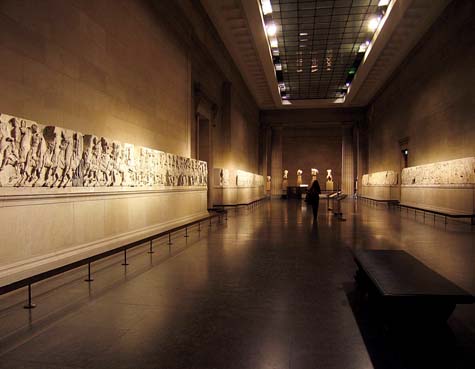 [Image: A view of the Elgin Marbles, via the Wik].BLDGBLOG [Image: A view of the Elgin Marbles, via the Wik].BLDGBLOG: That seems to be as much about the desire to encounter the thing itself as to use convenient stand-ins for that thing, when "authenticity" is simply too expensive to afford. Mary Beard: That’s partly it – but one thing that’s curious is that the modern city of Rome produced and displayed loads of plaster casts until quite recently (and there is still a great collection in the University gallery in Rome). They went in for making plaster casts of sculpture when they’d got the real stuff sitting right there in front of them. "Authenticity" is always a trickier idea than we think it is – which is, I guess, one of the things that "post-modernism" has been about telling us. BLDGBLOG: Do you see educational value in things like merchandising, then? Do souvenirs obscure the past or give people access to it? Mary Beard: I tend to be pretty laid back about it. I mean, I can do the argument about commodification if you like. I can say: goodness me, what you are doing? You’re re-presenting a tawdry cheap object, to make a vast amount of profit, and it’ll be bought by somebody else in the belief that, somehow, they have just bought into cultural property. I can do the gloomy side of it. But I think it also goes back, more positively, to the idea that these objects are sort of shared. How do you share a monument? One of the main ways that you share a monument is by replicating it and letting people own the replica. It’s a way that people can feel they have a relationship to the original. That’s been going on since antiquity itself. One of the things that’s quite extraordinary is the number of relatively small-scale replicas there are of the cult statue of Athena from the Parthenon – hundreds of them. Of course, in some ways, you say, tourists are being palmed off with plastic souvenirs instead of with knowledge – and, of course, some of these things, the middle class cultural critics can say, are horrible and cheap, and people think they’re buying culture when, in fact, they’re buying a nasty little replica. Obviously there’s an ambivalence there, but it never seems to me to be wholly bad. You know, you have your photograph taken at the Colosseum next to somebody dressed up like a gladiator. Is that a terrible bit of exploitation because you’ve just paid a ridiculous amount of money? Well, that’s exactly what it is in one way – but it’s also a way of writing yourself into the history of that site, and saying “I was there.” 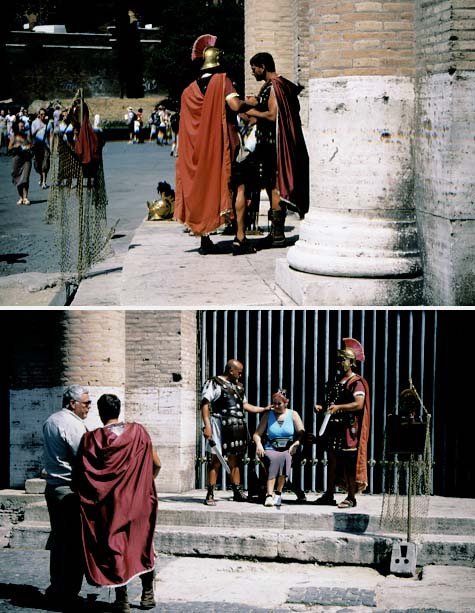 [Images: Tourists having their picture taken "next to somebody dressed up like a gladiator." Photo by Robin Cormack].BLDGBLOG [Images: Tourists having their picture taken "next to somebody dressed up like a gladiator." Photo by Robin Cormack].BLDGBLOG: For a lot of people, there’s also a sense of irony there – in the idea that you’d get your picture taken next to a gladiator. It’s like a joke: look at me, wearing shorts, standing next to an Italian guy dressed like a gladiator. Mary Beard: Yes, that’s right. I don’t think one’s capacity for self-ironization is necessarily incompatible with the idea of ownership. When I buy my ouzo bottle shaped like the Parthenon, it’s another way to the same end. We tend to think that tourists are dupes being flogged crap which they don’t realize is crap. Actually, I suspect that most people, like you and I, do realize that it’s crap. The point is to buy crap, because that’s part of what the deal is – that’s the transaction which you’re doing. I suppose it’s all part of what I’m thinking in general: people are much smarter about their engagement with these places than we often give them credit for. They/we have quite a highly developed sense of what the touristic game is all about. I might be an expert when it comes to the Parthenon, but I go to hundreds of places where I know nothing at all – but I still know what the contract is, between the tourist and the monument. 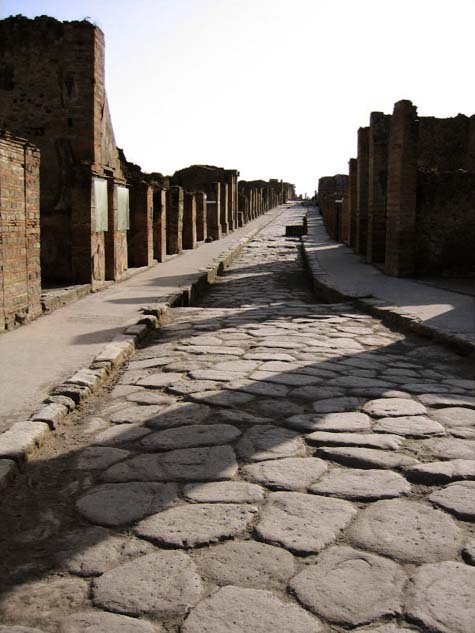 [Images: The streets of Pompeii, via Wikipedia].BLDGBLOG [Images: The streets of Pompeii, via Wikipedia].BLDGBLOG: This changes the subject a bit, but I understand you’re also writing a new book about Pompeii. Is that for the Wonders for the World? Mary Beard: I am writing a Pompeii book, and it’s for Profile and Harvard, like the Wonders. However, it’s not in the series because it’s going to be rather longer than that – and there’s a practical consideration here. If you’re going to tell your authors not to do more than 50,000 words, then you can’t have the series editor deciding she wants to do 100,000 words! I suppose I’m trying to do some quite specific things. I’ve worked on and off on Pompeii for 20 or 30 years, and it struck me that, apart from the study of volcanology (where everybody will talk till the cows come home about “pyroclastic flows” and all that), by and large there’s an increasing gap between what academic studies of Pompeii are doing and the kind of stuff that popular books on Pompeii feed people. I wanted to see if I could close a bit of that gap between what people normally get given, if they’re not specialists, and some of the ways of thinking about the city that are current within academic debate. I think that one of the problems about going to Pompeii, once you’ve done your first wander round it – and, even now, it’s gob-smacking to go to the ancient town – there’s a question of: what do people look at? And how do they look at it? I think, as we were saying before, tourists are pretty canny – but their canniness and sharpness is often crushed by the sense that there is a particular set of questions that are somehow the right questions to ask. I suppose I want to help people see that their puzzlement about how this town worked – their puzzlement about the city – is legitimate. You know, they should go on asking those kinds of questions. There is a huge distance between us and what went on in this town (whatever that was); yet, on the other hand, there is a dialogue that you can have with it. It’s a dialogue which is, in part, mediated by novels and films and so on – Last Days of Pompeii and the like. And that is something we have to work through, not against. It’s that way of thinking I’m interested in exploring. BLDGBLOG: You’ve written on your blog about Pompeii’s ancient traffic patterns, and about some more mundane questions, such as how Pompeii actually functioned. Mary Beard: Yes, that's right – you know: where did people go to the loo? Why is there so little "stuff" there? Why was so little found in Pompeii? Well, that really is interesting – and that is what archaeologists are sometimes honest enough to worry about. Where do these stairs actually go? Did anything happen up there? How many people lived here? So you want to say to tourists: your questions aren't foolish. We don’t know what the upstairs was like. Estimates of the population of Pompeii vary by thousands, according to whether you think all the slaves lived up there, squashed together in dorms, or whether there were some elegantly spacious master bedrooms, or whether it was mostly storeroom. We really don’t know. We don’t even know how Pompeii related to the sea! But I think there is a very difficult trade-off here. In the end it’s a terrible downer for people always to say, "We don’t know, we don’t know, we don’t know." You’ve got to tell them something that we do know! I suppose I want to write a book that doesn't fob people off with simplifying stories that I know not to be true. I think that's the nasty power relationship between popular books on the ancient world and their readers: an author, who knows how complicated it is, tells the ignorant reading public a simplified story that he or she doesn't really believe. That then makes writing – and disseminating what you know about the ancient world – an act of bad faith. So you want it to be good faith – without saying: the conclusion of this book is that we know nothing. BLDGBLOG: [ laughs] That reminds me of Robert Irwin’s book, where he begins with two full pages’ worth of incorrect "facts" about the Alhambra. Mary Beard: Yes. Jolly good. 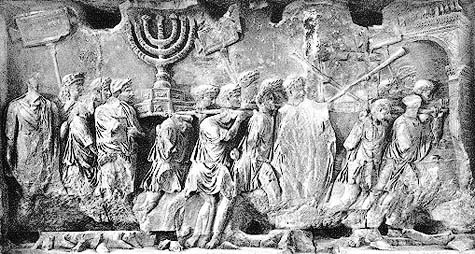 [Images: A Triumph through the streets of Rome following the sack of Jerusalem. For more on Roman Triumphs, don't miss Mary Beard's forthcoming book; for more on the sack of Jerusalem, grab a copy of Simon Goldhill's The Temple of Jerusalem].BLDGBLOG [Images: A Triumph through the streets of Rome following the sack of Jerusalem. For more on Roman Triumphs, don't miss Mary Beard's forthcoming book; for more on the sack of Jerusalem, grab a copy of Simon Goldhill's The Temple of Jerusalem].BLDGBLOG: You've also got another forthcoming book, published by Harvard, about the Roman Triumph – about Roman military processions. Could you tell me more about that? Is it similar in tone to the Wonders of the World series? Mary Beard: In a funny way, although it’s a longer book, and it’s heavily footnoted, it’s written partly for the same kind of audience. It’s for the specialist as well as the intelligent ignorant. What the book is saying is: look, here is a Roman ceremony which, much in the same way as these monuments, has been reworked and reappropriated throughout history. You know, Napoleon does the Triumph, every blasted princeling in the Renaissance does a Triumph, Mantegna paints the Triumph – it's still a cultural form that we share with the Romans. So how can we make sense of it? Particularly now, how do we think about celebrating military victory – and what form is possible, legitimate, in bad taste, in good taste...? This relates, of course, to how we now package the Romans. Certainly for the last hundred years or so, they have been seen as the poor relations of the Greeks: Greek culture, we believe, was intellectual and self-reflexive, whilst the Romans were thugs who built roads and won battles. It’s a convenient dyad for us but, in many ways, it undermines and disguises so much of what’s really interesting about Roman culture. One of the things I'm wanting to say about the Triumph goes like this. Here you've got the most fantastic parade ever of Roman wealth and imperialism. The Romans score disgustingly big victories, massacring thousands, and they come and celebrate it in the center of the city, bringing the prisoners and the spoils and the riches and all the rest. At one level, this is a jingoistic, militaristic display that would warm the heart of every European dictator ever after – but, at the same time, scratch the surface of that. Look at how the Romans talked about it. That very ceremony is also the ceremony in which you see the Romans debating and worrying about what glory is, what victory is, who really has won? It’s a ceremony that provides Rome with a way of thinking about itself. It exposes all kinds of Roman intellectual anxieties. For example, there are constant anecdotes, which I think are very loaded anecdotes, about how risky a celebration it is, and how the celebration can always go wrong. There's one General, Pompey, in the sixties BC, who decides to outbid all of the previous triumphant Generals. Instead of having his chariot yoked to horses, he decides to have it pulled by elephants. It looks fantastic – it looks kind of divine (that’s how the god Bacchus drove his chariot) – until he comes to go through an arch and the elephants get stuck in the arch. So he reverses a bit, and he tries it again – and they still can’t get through. They finally have to unhitch the elephants and bring up the horses – and you think: why is this anecdote being told? Not only is this obviously a humiliating moment – wouldn’t you feel a real fool if it happened to you! – but it’s also being told as a way of saying, remember, glory has to be carefully negotiated. Where is the boundary between glory and foolishness? Another question is: who do you look at when you’ve got this great procession? Who's the star of the show? Is it the General in his chariot? Well, sometimes it is – but sometimes it's the victims. Sometimes military victory makes stars of the defeated. That was also a problem in the gladiatorial arena: who was the star? Well, it was the gladiator, not the emperor. In the Triumph those exotic but pathetic captives regularly stole the show, or were said to, and Roman poets and historians recognized this, and wondered about it, and played with it, and they turned it into a metaphor just like we do. And that is so topical today. Take Saddam Hussein's execution – you know, what was the upshot of those films? Who won? Militarism often goes hand in hand with everything which undermines militarism. The Romans were actually – if you know how to read them right, and if you’re not expecting them to be Greek and to talk about it in the same way – they’re actually looking at the nature of military victory, and military display, and they’re wondering about it some of the same ways that we do. So that's what the book is about – or, at least, those are some of the questions that have driven it.  [Images: A poster for 300 and scenes from 300 and Gladiator].BLDGBLOG [Images: A poster for 300 and scenes from 300 and Gladiator].BLDGBLOG: Finally, could you talk a bit about the present state of pop cultural knowledge about the Classical world, from the film 300 and David Beckham’s new tattoo to cable television documentaries? In the most general sense, are these things useful for teaching the Classics? Mary Beard: I’m very keen on it, of course. I have to be. Partly, you know, if you’re a classicist teaching Classics at a British university, self-interest is a factor here. All these things, from Gladiator on, have been a tremendous recruiting ground, and so we go around talking about whether Gladiator’s true or not, and 300, and all the rest – and encouraging people to get interested in "real" Classics that way (there, I’m talking about authenticity!). More generally, though, one of the things that these movies and so on remind us is that classical culture simply isn’t the bastion of elitism that it’s often made out to be. Certainly in the UK – and, I expect, it’s largely the same in the U.S. – the study of Classics, as an academic discipline, is thought to be the upper echelons of privilege and elitism. To some extent that’s true – and to some extent it’s unfair. What that view overlooks is the fact that there has been enormous amounts of mass engagement with ancient culture from the end of the 19th century onwards. Books like The Last Days of Pompeii, or Ben-Hur, sold fantastic quantities. They were absolute bestsellers, in the way that Gladiator is a bestselling movie. What’s interesting though is that every generation has always claimed that it was the first to rediscover the Romans for themselves, and for mass culture. You can see that very clearly with the Broadway musical, A Funny Thing Happened On The Way To The Forum. It was a fantastic success, but it sold itself in very similar terms to Gladiator – that here, for the first time, the wee masses were going to see Rome as it really was. So what interests me, beyond the hope that this brings other people into Classics, is the idea that Classics is a subject which is actually quite democratic. It isn’t only this kind of toff, upper-class subject it’s often thought to be. Every generation enjoys rediscovering it – but, each time it comes around, we claim that now, for the first time, we’ve got privileged knowledge which we’re going to share with you all over again. In fact, there are hundreds and hundreds of movies, and hundreds of novels, and thousands of cartoon strips about the Romans. They never go away – but we always think that it’s us that got them first. In the UK, when kids discover Asterix the Gaul – a wonderful cartoon series about plucky little Gauls fighting the Romans – each 10-year old finds it anew, and rediscovers the Romans for themselves. Which is just how it should be.  [Image: The Colosseum, photographed by Robin Cormack].• • • [Image: The Colosseum, photographed by Robin Cormack].• • •BLDGBLOG owes a huge thank you to Mary Beard for taking the time to have this conversation, and for following up with images and with edits to the transcript. A huge thank you is also in line for my wife, who transcribed the entire hour-and-a-half recording and offered feedback on my original questions. For more Mary Beard, meanwhile, don't miss her blog, A Don's Life; her essays at the London Review of Books; or The Roman Triumph, due out this Autumn. Finally, titles in the Wonders of the World series now include: Collect them all... and don't miss Part One of this interview while you're doing so.
Mary Beard is a Professor of Classics at Cambridge University, where she is a fellow of Newnham College. She also writes a blog for the Times, called A Don's Life, and she is the editor of an excellent new series of books, The Wonders of the World. The latter is "a small series of books that will focus on some of the world's most famous sites or monuments." It is published by Profile in the UK, and by Harvard University Press in North America.  A few notable titles in that series include Mary Beard's own book about The Parthenon; her collaboration with Keith Hopkins for The Colosseum; Cathy Gere's extraordinary look at The Tomb of Agamemnon (previously discussed on BLDGBLOG here); and many others, including books about Westminster Abbey, The Temple of Jerusalem, and The Alhambra, with other titles ranging from the birth of Egyptology to the history of British railways and the First World War. Meanwhile, Beard has another, highly anticipated book forthcoming from Harvard University Press: The Roman Triumph. Among many other questions, that book will ask: "what are the implications of the Roman triumph, as a celebration of imperialism and military might, for questions about military power and 'victory' in our own day?" In the following two-part interview, Mary Beard talks to BLDGBLOG about the Wonders of the World series, including how and why the particular buildings and monuments have been chosen. We discuss the politics of archaeology and the often misguided reappropriation of the past; whether or not sites of historical horror can be transformed into places of both wonder and critical reflection; why we still know so little about the ruined city of Pompeii; how museums, guidebooks, and films, from Gladiator to 300, represent the Classical past; and even ancient Roman analogues for the death of Saddam Hussein. Part Two can be found here. 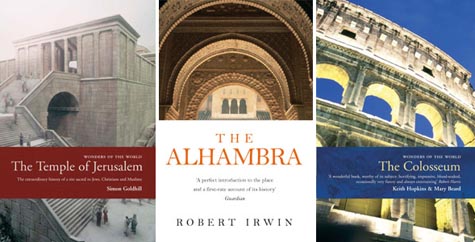 • • •BLDGBLOG • • •BLDGBLOG: To start with, what are the basic editorial intentions behind the Wonders of the World series? For instance, who are the books for? Mary Beard: You sometimes wonder whether you reinvent your editorial intentions as you go along! But I suppose there are three intentions. The first is that I want these books to open up culture and history, as well as dissent about culture and history, through the contested life stories of individual monuments and wonders – real or imaginary. I think it’s about using a single object – a single monument, a single wonder – as a kind of window onto not just culture and history but also the controversies of culture and history. That’s number one. Number two – and these are not meant to be hierarchical – is quite a simple one, and it’s to show that bricks and mortar, or concrete and marble, are always more than that. A great building is always more than the sum of its parts: it’s about mythology; it’s about argument; it’s about cultural re-use and re-presentation. And I think the third intention is that you want to help people to enjoy looking at monuments, and at the complexity of monuments – and to see that the complexity and the arguments are what’s fun about this. Sometimes, when people write for what they think of as a popular market, they think that they should make it simple, whereas I think that what you should be doing is helping people to enjoy how complicated it all really is. Of course, some of these buildings work better for one of those functions rather than others – but that’s the overall theme. 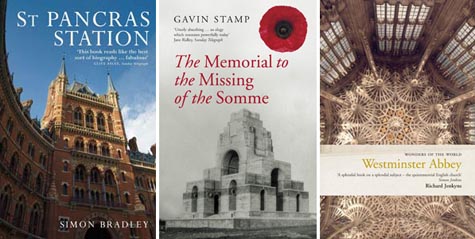 BLDGBLOG BLDGBLOG: When it comes to choosing an author to produce these books, do you go after people whose scholarly work you already admire – or do the authors come looking for you, pitching you ideas for a new monument or Wonder? Mary Beard: Increasingly, as people know the series, they’re starting to come forward and say, “I’ve got a great idea.” I think the key to it, though, is: one, they can’t be dull. I call it "academics with attitude" – they’ve got to have some sense of chutzpah about them. But I don’t think attitude is enough; I think the key is the kind of marriage you make between the writer and the monument – how you can make it work by getting the pairing right. That is, I think, quite difficult. One of the best examples I can think of is that we’ve been looking for someone – and may possibly now have found somebody – to do the Tower of London. Years ago I went out for lunch with Simon Bradley, an architectural historian, to talk about the Tower and whether he’d like to do it. He looked like a good prospect. So we were having lunch, but as we talked on and on about it, I got the sense that both of us were becoming just a bit bored with the blasted Tower of London. After a good drink or two, I finally said: "Look, Simon – forget the Tower. If you could have any building in the world, what building would you really, really like to write about?" And he instantly said: St. Pancras Station. Then it all came out: he was an architectural historian of the Gothic Revival by training, and he’d been a train enthusiast when he was a kid, and, suddenly, you saw: God – there was a building just waiting for the bloke. And, actually, it’s turned out to be an absolutely wonderful book. It’s that kind of slightly unlikely marriage that makes them work best – it’s about being a kind of dating agency. But there was something back in question one which we didn’t do – which is who the books are for. And we’re wanting to have as many readers as possible. Those might be specialists, or teachers, or high school students, or the man on the bus; but I think there is always a central nugget of people in the middle that I’ve got in mind when I’m commissioning a book, and I call them the intelligent ignorant. BLDGBLOG: [ laughs] I suppose I’m in that category. Mary Beard: And I’m quite good at being the clever ignorant, too! This goes back to what I said: people write popular books wanting to make things simple. I’m imagining that somebody who comes to this series may be ignorant, in the sense that they know nothing about the building they’re about to read about, beyond its name, or a very few facts – so they are, technically, ignorant. But I’m also assuming that they’re intelligent. What they do not want is to be shortchanged by oversimplification – and they do not want to be talked down to. They’re not going to take crap. So lots of specialists will pick up these books, in the way that they always do, but my target audience is the intelligent ignorant.  [Image: The interior iron arches of London's St. Pancras Station, via Wikipedia].BLDGBLOG [Image: The interior iron arches of London's St. Pancras Station, via Wikipedia].BLDGBLOG: How much thought goes into choosing the actual sites? Mary Beard: Quite a lot. This started off by me wanting to write about the Parthenon, and wanting to write about it for all the reasons that I’ve glossed as the editorial objectives of the series. But then it grew – and we saw that there was mileage in the idea. BLDGBLOG: I can think of a dozen or so places that would make fantastic books – the catacombs of Paris, the Maginot Line, Hoover Dam, Cape Canaveral, and so on – maybe even the International Space Station – but perhaps those don’t really fit the editorial mission of the series. Do sites like those have any interest for you? Mary Beard: Again, we want to range from the absolutely bog-standard, normative greatest hits that would be on anybody’s idea of a Wonder of the World, while, at the same time, we want to increase the range of those Wonders. There’s a trade off there, between not wanting to be boringly predictable, and, on the other hand, not wanting to be maverickly odd. One of things I want to do is to take some of the greatest hits, like St. Peter’s and Stonehenge, and show people how interesting and complicated and different they are – different from what those people might have imagined. But I also want to take things that people might never have thought of putting in the category of a Wonder. BLDGBLOG: Like St. Pancras? Mary Beard: I think St. Pancras in England is an absolutely extraordinary building, and, behind it, the rail sheds are incredible – in the engineering and in the architecture. It’s absolutely marvelous. So I’m very pleased to do that. Similarly, with something like Gavin Stamp’s The Memorial to the Missing of the Somme: what happens if you take something that people would say, “Oh, a war memorial” – and you say, no: think of it in a different way. Think about this as a Wonder of the World. And then you think about that monument differently. But I don’t know how far you can go down that line of being subversive. In some ways, we’re always teetering on the margins of where we might go next. One of the things that I’ve often said is: I wonder what happens if you do Auschwitz? Can you do sites of horror? Can you turn wonder around in that way? It would be hard to know how to do that in the series in a way that isn’t mawkish or that, in some way, makes the monument tawdry. It’s hard to know. 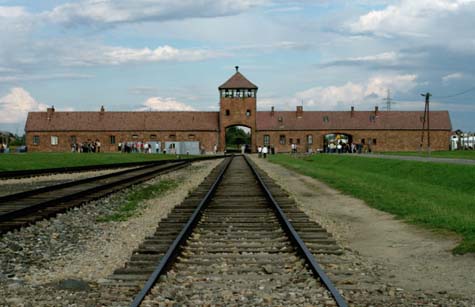 [Image: Tourists visiting Auschwitz-Birkenau; photo via Wikipedia].BLDGBLOG [Image: Tourists visiting Auschwitz-Birkenau; photo via Wikipedia].BLDGBLOG: That’s interesting, actually, because there was a short article in New Scientist a few months ago about the rise of so-called dark tourism – where people visit sites like Auschwitz and the Cambodian Killing Fields. So there is a connection between wonder and horror. Mary Beard: There was a book – which was not in the series, but which was published by Profile – by William St. Clair, about Cape Coast Castle, a British slave-trading castle on the west coast of Africa. That turned out to be extremely interesting. It expanded from being a Wonder partly because he found an enormously rich set of unexploited documentation. But we did talk quite a lot about whether the slave trade could produce wonder – if the slave trade could produce a Wonder of the World – and what that would mean. 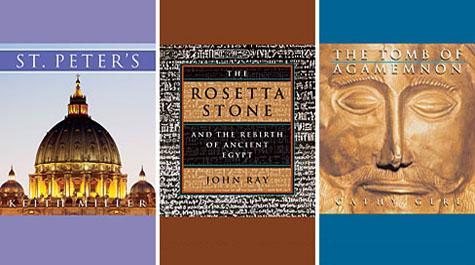 BLDGBLOG BLDGBLOG: Most of the books now focus on sites around the Mediterranean – with some exceptions, but those exceptions are all European. Do you see the series going on to include non-European sites like Macchu Picchu or the Taj Mahal? Mary Beard: Well, it is a bit European. In fact, one of the things about our list at the moment, and this is something that I really want to do something about, is that the Americas are striking by their absence. That’s something that’s on my mind. We have got the Forbidden City coming up, and the Taj Mahal, too – but there’s a striking lacuna where America, North or South, is concerned, and that’s something I want to think hard about. I’m also interested in natural wonders: the Grand Canyon is only made a natural wonder by cultural re-appropriation. Without that, it’s just a canyon. So why not the Grand Canyon? Similarly, too, the Alps were any old mountains – till they became Mountains. And the Lake District was just boggy hills till the blasted poets got at them. I think the boundaries of the Wonders of the World series are interesting – but, in the end, if all you did was invest in the margins, without re-looking – and I think it is a radical re-looking – at some of the things which seem more familiar, it would be a bit of a waste. BLDGBLOG: In other words, doing a book about Cape Canaveral would be a little too avant-garde. Mary Beard: I would go with a monument of space technology, actually, because I think you’d read it differently within the series. It’s just that I wouldn’t have too many volumes on Cape Canaveral and other things like that. It’s a question of productive balance. In the long term, I hope that the books will rub off on one another: you’ll read Westminster Abbey differently because you’ve read it after you’ve read about Cape Canaveral – and vice versa. If people like the series, and if they trust it, if they feel that there’s a guarantee of a decent read, then they’ll be encouraged to read things that they wouldn’t otherwise have read. I hope that’s what happens.  BLDGBLOG BLDGBLOG: I thought Cathy Gere’s book, The Tomb of Agamemnon, was incredible – in large part because it demonstrates how easily archaeology can become politicized. From your own experience, how easy is it for archaeological research, or just basic historical research, to become politicized – for the past to be deliberately reinterpreted in a way that benefits certain political narratives in the present? Mary Beard: That was one case where, even though I know a bit about prehistoric Greece, and I’ve done stuff on Schliemann, I fell into the category of the intelligent ignorant. I had really very little clue quite how loaded the tomb of Agamemnon became. It was extraordinary. It does seem to me that all these books do, in a sense, is say: look, these buildings matter. They’re not just bricks and mortar. They’ve been fought about. People want to own them, to make them theirs – because they know that they’re important. Quite how that happens I think is always an important story. It’s a way to find out more about political culture by a back door. In some ways, one learns a lot about the Nazification of Western Europe by thinking about Mycenae. But there’s also a sense of ownership going on here, in a more general sense – and, certainly, the Getty is a good place to sense that. There is an interesting problematization at the moment about cultural ownership, which is: do we think culture is moveable and global and shared? Or do we think that culture is national, and it belongs to the soil on which it was created? Should culture be owned by the people whose ancestors created it? I saw a statement quite recently – I don’t know if he was correctly quoted – by the Greek minister of culture, saying that, in his ideal world, everything produced in Greece would be in Greece. At that point you think: right, this is not about the restitution of things that have been illegally bought or smuggled or whatever; this is about a particular version of archaeological nationalism. At that point I start to feel very uneasy – and I would hope that these books help people to see that a narrowly vulgar archaeological nationalism is a very problematic idea. I was in the Met relatively recently, and I was walking through those rooms that have been reconstructed from British country houses, and I thought: do I feel pleased that these rooms are here? Or do I feel like what have you got your hands on these for? Which do I feel? Obviously, to some extent, you feel both – but on balance I feel more pleased than cross, because the idea that bits of my culture can be found globally, that I can go into a museum in New York and see something from Gloucestershire, actually pleases me as much as it makes me anxious. I did also go to the Mellon Center for British Art, in New Haven, a few weeks ago – a marvelous collection of British art. It made me say: here I am, a very well-educated, cultural middle-class Brit, and this collection of British art in New Haven, displayed in a way that I’d never seen British art displayed before, has made me think differently about my own culture, in a way that would have been impossible had these been in the UK. So, leaving aside the fraught issues of criminality or theft, which is one thing, the idea is whether we can think of these things as bits of shared cultural property. I mean, what happens when a building becomes a Wonder of the World? One of the interesting consequences, I think, is a series of tough questions. In what sense do we own these things? In what sense can these things really be shared? Do we feel pleased that there’s a bit of the Parthenon in the Louvre – or do we think it should go back? I increasingly come down on the side of feeling pleased – although ambivalent. 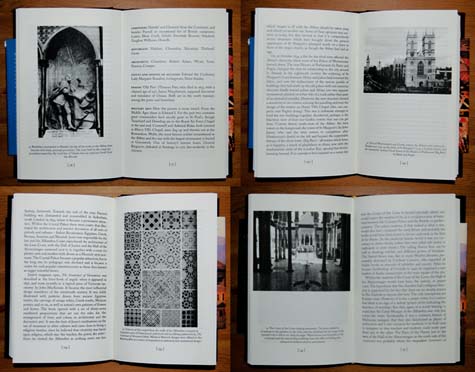 BLDGBLOG BLDGBLOG: I think a lot of this, though, comes down to the specific historical relationship between the countries involved. The U.S. having British artifacts in a museum means one thing, whereas, say – Mary Beard: Having the Benin bronzes means quite another. BLDGBLOG: Exactly. It has a different set of political implications. But that’s also why it can be hard sometimes to distinguish between archaeology as a science, and archaeology as a political pursuit – politics, or even empire, pursued by other means. Mary Beard: Yes – I think there’s always a trade-off, and it’s always murky. Different sides will tell you different stories and give you different interpretations of exactly the same series of events. I think you can see that very clearly with Mussolini. It is one of the clearest cases: you could say that Mussolini was re-excavating Ancient Rome in order to make a political statement about his own genealogy. He wasn’t saying: "Wouldn’t it be interesting to know what the Mausoleum of Augustus looks like?" He was trying to excavate the monumental center of ancient Rome as a legitimation of his own regime. It’s clear that’s why the money went in. It’s not half so clear that the individual archaeologists, in receipt of that money, were on message in quite the way that they appear to have been. Some time ago I got a group of my colleagues in Cambridge together. All of them were eighty and over, and all of them had been in Italy when the big Mussolini excavations were going on. One of them was an ex-member of the Communist party; others were highly unpoliticised. I got a group of students, interested in finding out about this, to ask the group questions about what being in Rome in the 1930s was all about. I expected at least the highly political ones would give me, possibly an anachronistic reading, but a very political reading about distaste for the appropriation of archaeology for political ends. I couldn’t have been more surprised – because every single one of them said, "It was amazing. It was marvelous. So much stuff was being discovered." I thought gosh, you know, the reading of this is actually extremely complicated in terms of how the politics worked – and how our view of it changes over time. I mean, it’s easier to spot political motives a generation or two after the event. Another thing: one of the most famous excavations in Pompeii was the excavation of the Villa of the Mysteries and its frieze, first published in the 1930s. These were fantastically lavish volumes – you know, more expensive that you would ever imagine, in a fantastic vellum binding – which my library in Cambridge managed to get a copy of. The book's got Mussolini's fasces on the back cover, in gold emboss, and, instead of being dated 1938, it's dated Era Fascista VII or something. So we got a group of students together and we passed the book round, and we said, "Do you notice anything about this book? Now, don’t think of the pictures – look at it as a book. Do you notice anything about it?" And most of the students said, "Well it’s lovely. It's really expensive, isn't it?" It took them about a quarter of an hour before a single one of them said, "Oh, what’s this here?" pointing to the fasces and the dating by Era Fascista. And I thought, actually, they're both right and wrong. They're wrong because they're being very unobservant and they've failed to see why this bit of archaeology was published as lavishly as it was, and it was having money plowed into it by a regime that they would purport to disdain. And yet here this has entered their own academic life, in a way that is somehow separate from those considerations. I thought that that was quite a neat example, and a nice little vignette of how these monuments work. I went to the Ara Pacis, in Rome, with the new Richard Meier cover to it – and what was interesting about that was that, if you go in and you're not going to buy the expensive guidebook, if you're just going to go in as a tourist and use the information panels, then you would have to look very hard to discover that this was excavated by Mussolini and then put into a fascist box that has now been removed – although it's sitting in the middle of a square surrounded by fascist sculpture!  [Image: Benito Mussolini, via Wikipedia].BLDGBLOG [Image: Benito Mussolini, via Wikipedia].BLDGBLOG: That brings up the question of what tourists are really looking for when they go out to visit "history." We’ve talked about the political side of this – but what do tourists want from the past? Mary Beard: What’s funny about the "wonders of the world" idea is that it’s such a lasting metaphor for the must-see thing. The category starts in Hellenistic Greece. Greeks in the third and second century BC were making all kinds of lists and all kinds of categories, and they were terribly busy systematizing things. Most of that we’ve forgotten, but the idea of the "wonders of the world" proved to be terribly lasting. In some ways, it feeds into the whole Grand Tour – a very elite British Grand Tour, obviously. What it does now, I think, is it enriches tourism hugely. I think one of the most exciting things about visiting these monuments – like the Parthenon, or the Colosseum, etc. – is in going to see what our predecessors saw, but differently. I think the buzz you get from going to, say, the Colosseum is not just: "Oh my goodness, this is where gladiators fought and bled their guts out on the sand!" But also: "This is where Byron came." And: "This is where Henry James came." There’s a sense of revisiting the recent as well as the remote past – and wondering, “Does it look the same to me as it did to Byron?" Is it oppressive to be seeing through the eyes of these other people – or is that actually a wonderful enjoyment of historical "thickness"? For my taste, most popular tourist books are dishonest to the extent that they pretend there's a kind of unmediated access between you and the past. So when you go to the Colosseum, and when you go to the Parthenon, there’s you and the fifth century BC, or there’s you and the first century AD – when, in fact, you’re not seeing the first century AD or the fifth century BC, you’re seeing it as it has been reconstructed, rebuilt, written about, and talked about. You're only there because somebody in 1780 decided to draw it. I want to bring that bit back in – the "thickness" of tourism's history being its own pleasure. 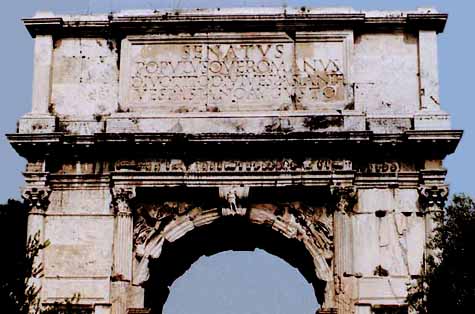 [Image: The Arch of Titus, via Wikipedia].• • • [Image: The Arch of Titus, via Wikipedia].• • •Don't miss Part Two of this interview.
|
|
 [Image: The reconstructed abbey atop Monte Cassino, as photographed by Stephanie Kuykendal for The New York Times].
[Image: The reconstructed abbey atop Monte Cassino, as photographed by Stephanie Kuykendal for The New York Times].
 [Image:
[Image:  Some of the "surprisingly agreeable" sounds discovered thus far include "car tyres on wet, bumpy asphalt, the distant roar of a motorway flyover, the rumble of an overground train and the thud of heavy bass heard on the street outside a nightclub."
Some of the "surprisingly agreeable" sounds discovered thus far include "car tyres on wet, bumpy asphalt, the distant roar of a motorway flyover, the rumble of an overground train and the thud of heavy bass heard on the street outside a nightclub." [Image: The South Tower of the World Trade Center on 9/11; photographer unknown].
[Image: The South Tower of the World Trade Center on 9/11; photographer unknown]. [Image: "Within a few hours’ time, a person exposed to the fumes could ingest toxins that would otherwise take a year to accumulate in a typical environment"; photographer unknown].
[Image: "Within a few hours’ time, a person exposed to the fumes could ingest toxins that would otherwise take a year to accumulate in a typical environment"; photographer unknown]. [Image: After the towers' collapse; photographer unknown].
[Image: After the towers' collapse; photographer unknown]. [Image: Famous buildings in Chicago, via the
[Image: Famous buildings in Chicago, via the  [Image: Glowing pavilion by
[Image: Glowing pavilion by  [Image: A spectacular glimpse of the Leonid meteor shower, circa 1999; photo by
[Image: A spectacular glimpse of the Leonid meteor shower, circa 1999; photo by  [Image: Habitat 825, by
[Image: Habitat 825, by 

 [Images: Habitat 825, by
[Images: Habitat 825, by  Case in point: the St. Marylebone school.
Case in point: the St. Marylebone school. 
 [Images: Gardner 1050, by
[Images: Gardner 1050, by 
 [Images: The Fineman house, by
[Images: The Fineman house, by  [Image: Proposal for CalArts, by
[Image: Proposal for CalArts, by  [Image: The Norton Avenue Lofts, by
[Image: The Norton Avenue Lofts, by 
 [Images: The Norton Avenue Lofts, by
[Images: The Norton Avenue Lofts, by  [Image: 12 Houses by architect
[Image: 12 Houses by architect  [Image: 12 Houses by architect
[Image: 12 Houses by architect  [Image: 12 Houses by architect
[Image: 12 Houses by architect  North Carolina-based architect
North Carolina-based architect  [Images: The
[Images: The  The map is initially quite confusing, but it shows that London will have the climate of Lisbon, Portugal; Berlin will have the climate of northern Algeria (!); and Oslo will feel like Barcelona (and so on).
The map is initially quite confusing, but it shows that London will have the climate of Lisbon, Portugal; Berlin will have the climate of northern Algeria (!); and Oslo will feel like Barcelona (and so on).  They had noticed, apparently, that some recent fires involving stately old Victorians occurred immediately after those houses' residents had got divorced.
They had noticed, apparently, that some recent fires involving stately old Victorians occurred immediately after those houses' residents had got divorced.  What really happened, the psychiatrist proposed, was that the houses themselves had been blamed, or scapegoated, for the interpersonal strife that once occurred within them – and those houses had thus been destroyed.
What really happened, the psychiatrist proposed, was that the houses themselves had been blamed, or scapegoated, for the interpersonal strife that once occurred within them – and those houses had thus been destroyed.  [Image: The
[Image: The 
 [Images: Michelle Kaufmann's
[Images: Michelle Kaufmann's 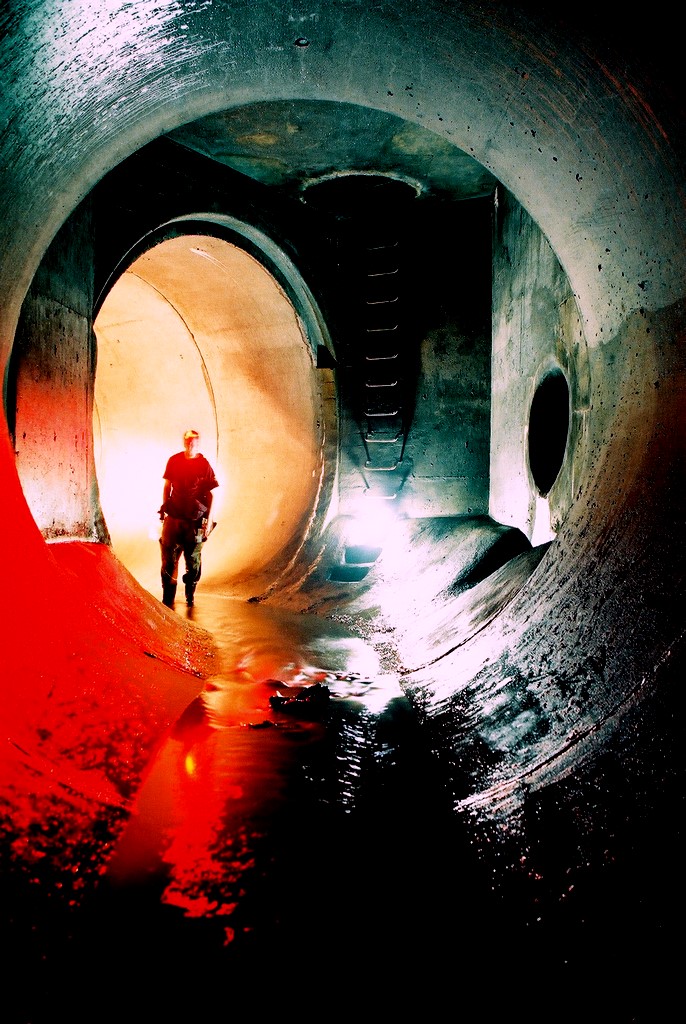 [Image: Another freakishly beautiful photograph by
[Image: Another freakishly beautiful photograph by  In this installment we discuss cultural authenticity and the rise of archaeo-tourism; China, the pirating of ancient history, and plaster casts of statuary; A Funny Thing Happened On The Way To The Forum; the little-understood lost lifestyle patterns of the pyroclastically entombed Pompeii; and the urban military spectacles of imperial Rome.
In this installment we discuss cultural authenticity and the rise of archaeo-tourism; China, the pirating of ancient history, and plaster casts of statuary; A Funny Thing Happened On The Way To The Forum; the little-understood lost lifestyle patterns of the pyroclastically entombed Pompeii; and the urban military spectacles of imperial Rome.  [Image: A view of the Elgin Marbles, via the
[Image: A view of the Elgin Marbles, via the  [Images: Tourists having their picture taken "next to somebody dressed up like a gladiator." Photo by Robin Cormack].
[Images: Tourists having their picture taken "next to somebody dressed up like a gladiator." Photo by Robin Cormack]. [Images: The streets of Pompeii, via
[Images: The streets of Pompeii, via  [Images: A Triumph through the streets of Rome following the sack of Jerusalem. For more on Roman Triumphs, don't miss Mary Beard's
[Images: A Triumph through the streets of Rome following the sack of Jerusalem. For more on Roman Triumphs, don't miss Mary Beard's  [Images: A poster for
[Images: A poster for  [Image: The Colosseum, photographed by Robin Cormack].
[Image: The Colosseum, photographed by Robin Cormack].
 BLDGBLOG: When it comes to choosing an author to produce these books, do you go after people whose scholarly work you already admire – or do the authors come looking for you, pitching you ideas for a new monument or Wonder?
BLDGBLOG: When it comes to choosing an author to produce these books, do you go after people whose scholarly work you already admire – or do the authors come looking for you, pitching you ideas for a new monument or Wonder? [Image: The interior iron arches of London's St. Pancras Station, via
[Image: The interior iron arches of London's St. Pancras Station, via  [Image: Tourists visiting Auschwitz-Birkenau; photo via
[Image: Tourists visiting Auschwitz-Birkenau; photo via  BLDGBLOG: Most of the books now focus on sites around the Mediterranean – with some exceptions, but those exceptions are all European. Do you see the series going on to include non-European sites like Macchu Picchu or the Taj Mahal?
BLDGBLOG: Most of the books now focus on sites around the Mediterranean – with some exceptions, but those exceptions are all European. Do you see the series going on to include non-European sites like Macchu Picchu or the Taj Mahal? BLDGBLOG: I thought Cathy Gere’s book,
BLDGBLOG: I thought Cathy Gere’s book,  BLDGBLOG: I think a lot of this, though, comes down to the specific historical relationship between the countries involved. The U.S. having British artifacts in a museum means one thing, whereas, say –
BLDGBLOG: I think a lot of this, though, comes down to the specific historical relationship between the countries involved. The U.S. having British artifacts in a museum means one thing, whereas, say – [Image: Benito Mussolini, via
[Image: Benito Mussolini, via  [Image: The Arch of Titus, via
[Image: The Arch of Titus, via 


